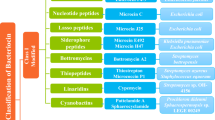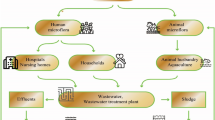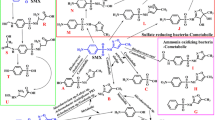Abstract
The application of thermophilic anaerobic digestion (TAD) treatments to dairy manure in a biogas plant was evaluated to investigate whether the prominent countermeasure was sufficient for the dissemination of antimicrobial-resistant (AMR) bacteria in the dairy industry. To determine the changes in the number of AMR bacteria in dairy manure after TAD, cefazolin-resistant (CEZ-R) and ampicillin-resistant (AMP-R) bacteria in dairy manure and digestate were quantified by plate spread methods performed with combinations of antimicrobials added to agar plates and selective and differential agar plates. In addition, extended-spectrum β-lactamase (ESBL)-producing bacteria were also quantified to evaluate the effect of TAD on plasmid-borne resistant bacteria. CEZ-R and AMP-R bacteria were widely reduced after TAD compared with the susceptible bacteria against these antimicrobials. The classification into E. coli, other coliforms, and non-coliform bacteria revealed that CEZ-R and AMP-R coliform bacteria were more significantly reduced than non-coliform bacteria by TAD. Moreover, ESBL-producing bacteria were reduced significantly among CEZ-R bacteria. From these results, TAD appears to be a useful treatment to counter the dissemination of AMR bacteria in dairy manure by the preferential elimination of AMR bacteria.



Similar content being viewed by others
References
Roca I, Akova M, Baquero F, Carlet J, Cavaleri M, Coenen S, Cohen J, Findlay D, Gyssens I, Heure OE, Kahlmeter G, Kruse H, Laxminarayan R, Liébana E, López-Cerero L, MacGowan A, Martins M, Rodríguez-Baño J, Rolain JM, Segovia C, Sigauque B, Tacconelli E, Wellington E, Vila J (2015) The global threat of antimicrobial resistance: science for intervention. New Microbes New Infect 6:22–29. https://doi.org/10.1016/j.nmni.2015.02.007
Asai T, Kojima A, Harada K, Ishihara K, Takahashi T, Tamura Y (2005) Correlation between the usage volume of veterinary therapeutic antimicrobials and resistance in Escherichia coli isolated from the feces of food-producing animals in Japan. Jpn J Infect Dis 58:369–372
Furuya EY, Franklin DL (2006) Antimicrobial-resistant bacteria in the community setting. Nat Rev Microbiol 4:36–45. https://doi.org/10.1038/nrmicro1325
The National Veterinary Assay Laboratory, Ministry of Agriculture, Forestry, and Fisheries (2013) Report of the Japanese veterinary antimicrobial resistance monitoring system—2008 to 2011. http://www.maff.go.jp/nval/. Accessed 23 Mar 2017
Iwasaki M, Yamashiro T, Beneragama N, Nishida T, Kida K, Ihara I, Takahashi J, Umetsu K (2011) The effect of temperature on survival of pathogenic bacteria in biogas plants. Anim Sci J 82:707–712. https://doi.org/10.1111/j.1740-0929.2011.00887.x
Brinas L, Moreno MA, Zarazaga M, Porrero C, Saenz Y, García M, Dominguez L, Torres C (2003) Detection of CMY-2, CTX-M-14, and SHV-12 β-lactamases in Escherichia coli fecal-sample isolates from healthy chickens. Antimicrob Agents Chemother 47:2056–2058
Jacoby GA (2006) β-Lactamase nomenclature. Antimicrob Agents Chemother 50:1123–1129. https://doi.org/10.1128/AAC.50.4.1123-1129.2006
Batchelor M, Threlfall EJ, Liebana E (2005) Cephalosporin resistance among animal-associated Enterobacteria: a current perspective. Expert Rev Anti Infect Ther 3:403–417. https://doi.org/10.1586/14787210.3.3.403
Carattoli A (2008) Animal reservoirs for extended spectrum β-lactamase producers. Clin Microbiol Infect 14(Suppl 1):117–123. https://doi.org/10.1111/j.1469-0691.2007.01851.x
Asuming-Brempong S, Aferi NK (2014) Isolation of phosphate solubilizing bacteria from tropical soil. Glob Adv Res J Agric Sci 3:8–15
Lowe SE, Jain MK, Zeikus JG (1993) Biology, ecology, and biotechnological applications of anaerobic bacteria adapted to environmental stresses in temperature, pH, salinity, or substrates. Microbiol Rev 57:451–509
Sahlstrom L (2003) A review of survival of pathogenic bacteria in organic waste used in biogas plants. Bioresour Technol 87:161–166. https://doi.org/10.1016/S0960-8524(02)00168-2
Desbois AP, Smith VJ (2010) Antibacterial free fatty acids: activities, mechanisms of action and biotechnological potential. Appl Microbiol Biotechnol 85:1629–1642. https://doi.org/10.1007/s00253-009-2355-3
Aldsworth TG, Sharman RL, Dodd CER (1999) Bacterial suicide through stress. Cell Mol Life Sci 56:378–383. https://doi.org/10.1007/s000180050439
Palleroni NJ (2005) Genus I. Pseudomonas. In: Brenner DJ, Krieg NR, Staley JT, Garrity GM (eds) Bergey’s Manual of Systematic Bacteriology, vol 2, 2nd edn. Springer, East Lansing, pp 323–379
Qi G, Pan Z, Sugawa Y, Andriamanohiarisoamanana FJ, Yamashiro T, Iwasaki M, Kawamoto K, Ihara I, Umetsu K (2018) Comparative fertilizer properties of digestates from mesophilic and thermophilic anaerobic digestion of dairy manure: focusing on plant growth promoting bacteria (PGPB) and environmental risk. J Mater Cycles Waste. https://doi.org/10.1007/s10163-018-0708-7
Acknowledgements
This study was supported in part by a Grant-in-Aid for Scientific Research from the Ministry of Education, Culture, Sports, Science and Technology (MEXT) of Japan (No. 10670499).
Author information
Authors and Affiliations
Corresponding author
Rights and permissions
About this article
Cite this article
Iwasaki, M., Miyake, M., Maseda, H. et al. Thermophilic anaerobic digestion is an effective treatment for reducing cefazolin-resistant bacteria and ESBL-producers in dairy manure. J Mater Cycles Waste Manag 21, 293–299 (2019). https://doi.org/10.1007/s10163-018-0789-3
Received:
Accepted:
Published:
Issue Date:
DOI: https://doi.org/10.1007/s10163-018-0789-3




